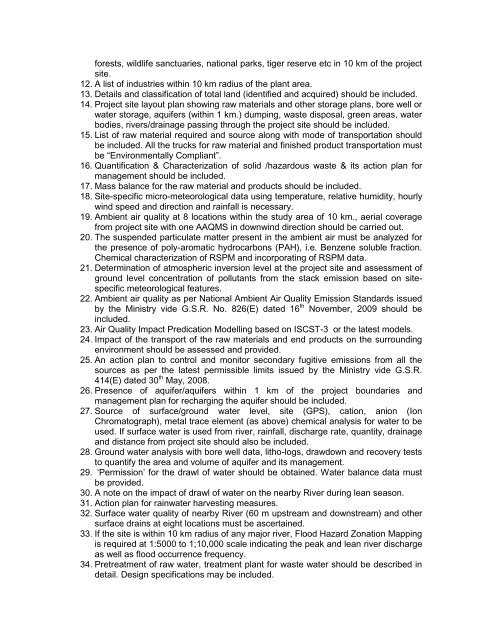MINUTES OF2ND RECONSTITUTED EXPERT APPRAISAL ...
MINUTES OF2ND RECONSTITUTED EXPERT APPRAISAL ...
MINUTES OF2ND RECONSTITUTED EXPERT APPRAISAL ...
- No tags were found...
You also want an ePaper? Increase the reach of your titles
YUMPU automatically turns print PDFs into web optimized ePapers that Google loves.
forests, wildlife sanctuaries, national parks, tiger reserve etc in 10 km of the projectsite.12. A list of industries within 10 km radius of the plant area.13. Details and classification of total land (identified and acquired) should be included.14. Project site layout plan showing raw materials and other storage plans, bore well orwater storage, aquifers (within 1 km.) dumping, waste disposal, green areas, waterbodies, rivers/drainage passing through the project site should be included.15. List of raw material required and source along with mode of transportation shouldbe included. All the trucks for raw material and finished product transportation mustbe “Environmentally Compliant”.16. Quantification & Characterization of solid /hazardous waste & its action plan formanagement should be included.17. Mass balance for the raw material and products should be included.18. Site-specific micro-meteorological data using temperature, relative humidity, hourlywind speed and direction and rainfall is necessary.19. Ambient air quality at 8 locations within the study area of 10 km., aerial coveragefrom project site with one AAQMS in downwind direction should be carried out.20. The suspended particulate matter present in the ambient air must be analyzed forthe presence of poly-aromatic hydrocarbons (PAH), i.e. Benzene soluble fraction.Chemical characterization of RSPM and incorporating of RSPM data.21. Determination of atmospheric inversion level at the project site and assessment ofground level concentration of pollutants from the stack emission based on sitespecificmeteorological features.22. Ambient air quality as per National Ambient Air Quality Emission Standards issuedby the Ministry vide G.S.R. No. 826(E) dated 16 th November, 2009 should beincluded.23. Air Quality Impact Predication Modelling based on ISCST-3 or the latest models.24. Impact of the transport of the raw materials and end products on the surroundingenvironment should be assessed and provided.25. An action plan to control and monitor secondary fugitive emissions from all thesources as per the latest permissible limits issued by the Ministry vide G.S.R.414(E) dated 30 th May, 2008.26. Presence of aquifer/aquifers within 1 km of the project boundaries andmanagement plan for recharging the aquifer should be included.27. Source of surface/ground water level, site (GPS), cation, anion (IonChromatograph), metal trace element (as above) chemical analysis for water to beused. If surface water is used from river, rainfall, discharge rate, quantity, drainageand distance from project site should also be included.28. Ground water analysis with bore well data, litho-logs, drawdown and recovery teststo quantify the area and volume of aquifer and its management.29. ‘Permission’ for the drawl of water should be obtained. Water balance data mustbe provided.30. A note on the impact of drawl of water on the nearby River during lean season.31. Action plan for rainwater harvesting measures.32. Surface water quality of nearby River (60 m upstream and downstream) and othersurface drains at eight locations must be ascertained.33. If the site is within 10 km radius of any major river, Flood Hazard Zonation Mappingis required at 1:5000 to 1;10,000 scale indicating the peak and lean river dischargeas well as flood occurrence frequency.34. Pretreatment of raw water, treatment plant for waste water should be described indetail. Design specifications may be included.
















